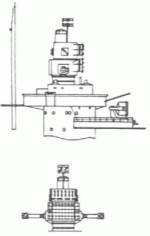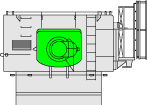John Camp
Well-known
I have a point and shoot, a 7mp Pentax Optio 750z.
It has a manual mode in which you can set both f-stop and speed (it's an f/2.8.)
It has an optical view finder that is NOT through the lens, but is linked to the zoom lens (so it zooms when the lens does.)
It also has a through-the-lens twistable LCD on the back.
Could this in anyway be considered a rangefinder? Or is it just a regular old horsebleep P&S?
By the way, I wonder why Leica couldn't come up with a linked zooming VF so that frames would be unnecessary? Or is that one of those "burn witch" issues?
JC
It has a manual mode in which you can set both f-stop and speed (it's an f/2.8.)
It has an optical view finder that is NOT through the lens, but is linked to the zoom lens (so it zooms when the lens does.)
It also has a through-the-lens twistable LCD on the back.
Could this in anyway be considered a rangefinder? Or is it just a regular old horsebleep P&S?
By the way, I wonder why Leica couldn't come up with a linked zooming VF so that frames would be unnecessary? Or is that one of those "burn witch" issues?
JC
lushd
Donald
Absolutely no pretensions to expertise but for me a rangefinder is defined by the focussing system. The double image in the viewfinder from the two little windows on the front, an optical system linked to the lens that means that when the two images coincide on an object then it's in focus at the film or CCD plane. If it doesn't work that way I believe it can't be called a rangefinder.
S
Socke
Guest
I don't think it's a rangefinder in the traditional sense since AF works through the lense and not by triangulation.
Even the Contax G which has a triangulating rangefinder is not considered as a rangefinder by some people.
And since I'm talking Contax G, it has a zooming viewfinder without need for framelines, this has pros and cons. First of all, you can not see outside the framelines and last but not least it is smaller and dimmer than fixed viewfinders. On the pro side, it adjust for focusing distance and parallax so what you see is what you get, or to be true, what you see is some 97% of what you'll get
Even the Contax G which has a triangulating rangefinder is not considered as a rangefinder by some people.
And since I'm talking Contax G, it has a zooming viewfinder without need for framelines, this has pros and cons. First of all, you can not see outside the framelines and last but not least it is smaller and dimmer than fixed viewfinders. On the pro side, it adjust for focusing distance and parallax so what you see is what you get, or to be true, what you see is some 97% of what you'll get
Dougg
Seasoned Member
Technically not a rangefinder, no... But if you use only the optical viewfinder for framing, then it would be a "direct view" camera, as Roger Hicks defined it. I think we accept the RF-less Bessa-L despite its lack of rangefinder, so I think there must be a "rangefinder way" of shooting involved too. Say if you lock the mirror up on your SLR and slap an accessory viewfinder on the shoe, it becomes the functional equivalent of the Bessa-L, used in the same way... and that would be quite a different way. Like using an RF camera on zone/range/hyperfocal focus. It's conceivable the Optio might be used in some rangefinder way...
Dougg
Seasoned Member
Might take a look at Hicks's book "Rangefinder: Equipment, History, techniques." I think he makes a good point that there's a considerable similarity in photographing with cameras using optical viewfinders, in contrast to those cameras which use indirect viewing with the scene imaged on a screen of some kind (ground glass or LCD). So he proposed a super-class called "Direct View" cameras of which cameras with rangefinders are a part. The few models with no built-in viewfinder, from the Bessa-L at the low end to the current Alpa offerings far above, can be considered Direct View cameras too, just with interchangeable viewfinders.
There are fascinating variations in Direct View cameras, including add-on accessory rangefinders, folding finders with no optics, one having an RF but no built-in viewfinder, uncoupled built-in rangefinders, coupled RFs separate from the viewfinder, and so on... A rich field for examination!
There are fascinating variations in Direct View cameras, including add-on accessory rangefinders, folding finders with no optics, one having an RF but no built-in viewfinder, uncoupled built-in rangefinders, coupled RFs separate from the viewfinder, and so on... A rich field for examination!
Finder
Veteran
Your camera has a "viewfinder," not a "rangefinder." So it is a viewfinder camera. These technical terms and classifications are old and established. I am not sure tacking on "rangefinder" to a camera that is not a rangefinder changes what it is (or isn't) even if you modify it with "emotional." There is nothing inferior to a viewfinder camera that uses another method of focusing.
The question of the Contax G series or Konica Hexar AF is a little trickier. Certainly a rangefinder does not need to be optical. There are electronic rangefinder devices. Those cameras can be described as electronic rangefinders.
The question of the Contax G series or Konica Hexar AF is a little trickier. Certainly a rangefinder does not need to be optical. There are electronic rangefinder devices. Those cameras can be described as electronic rangefinders.
jaapv
RFF Sponsoring Member.
Dougg said:Might take a look at Hicks's book "Rangefinder: Equipment, History, techniques." I think he makes a good point that there's a considerable similarity in photographing with cameras using optical viewfinders, in contrast to those cameras which use indirect viewing with the scene imaged on a screen of some kind (ground glass or LCD). So he proposed a super-class called "Direct View" cameras of which cameras with rangefinders are a part. The few models with no built-in viewfinder, from the Bessa-L at the low end to the current Alpa offerings far above, can be considered Direct View cameras too, just with interchangeable viewfinders.
There are fascinating variations in Direct View cameras, including add-on accessory rangefinders, folding finders with no optics, one having an RF but no built-in viewfinder, uncoupled built-in rangefinders, coupled RFs separate from the viewfinder, and so on... A rich field for examination!
Do you mean it needs something like this??
Attachments
Last edited:
KoNickon
Nick Merritt
I don't quite buy into Roger Hicks's "direct view" idea, simply because I regard an SLR, where you're seeing what the lens sees, as about as "direct view" as you can get. All semantics, of course.
Dougg
Seasoned Member
Maybe it comes down to what "direct" means.KoNickon said:I don't quite buy into Roger Hicks's "direct view" idea, simply because I regard an SLR, where you're seeing what the lens sees, as about as "direct view" as you can get. All semantics, of course.
Will
Well-known
jaapv said:Do you mean it needs something like this??
What's the RF's effective base lenght? LOL
Socke said:I don't think it's a rangefinder in the traditional sense since AF works through the lense and not by triangulation.
Even the Contax G which has a triangulating rangefinder is not considered as a rangefinder by some people.
And since I'm talking Contax G, it has a zooming viewfinder without need for framelines, this has pros and cons. First of all, you can not see outside the framelines and last but not least it is smaller and dimmer than fixed viewfinders. On the pro side, it adjust for focusing distance and parallax so what you see is what you get, or to be true, what you see is some 97% of what you'll get
lushd said:Absolutely no pretensions to expertise but for me a rangefinder is defined by the focussing system. The double image in the viewfinder from the two little windows on the front, an optical system linked to the lens that means that when the two images coincide on an object then it's in focus at the film or CCD plane. If it doesn't work that way I believe it can't be called a rangefinder.
Having handled a Contax G a long time I go, I would agree with Donald. You do need a double image system to call it a RF.
Share:
-
This site uses cookies to help personalise content, tailor your experience and to keep you logged in if you register.
By continuing to use this site, you are consenting to our use of cookies.



